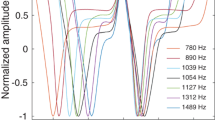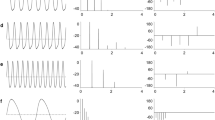Summary
Undisturbed specimens of Gymnotus carapo discharge their electric organs at a rate of approximately 50 Hz, with a standard deviation of 3 Hz; stimuli of several sensory modalities (touch, vibration, light, electric fields) are capable of eliciting transient increases in discharge frequency rising to a maximum near 30 Hz above resting frequency and returning exponentially over several seconds. Such frequency transients may be evoked by sudden increases or decreases in the electrical resistance of the environment caused by shunting recording electrodes on either end of the fish. Threshold responses are seen to resistance changes of 10 to 20 ohms, which create changes of approximately 50 μV/cm in the amplitude of the electric discharge measured along the length of the fish.
Gymnotus proves remarkably sensitive to electrical stimuli occuring in phase with the discharge train of its own electric organs, with a threshold near 50 μV/cm; out-of-phase stimuli ten times this amplitude fail to elicit frequency transients. Responses are also seen to small changes in latency between stimulus and discharge trains within the time span of an individual organ discharge.
Phase-sensitivity is apparently a consequence of the sigmoid stimulus/response curve common to most receptors; a large “activating” pulse, normally generated by the electric organs, raises electroreceptor activity into the receptor's dynamic range, after which a relatively small stimulus is capable of causing a significant change in output. Such a mechanism probably serves as a peripheral filter, eliminating low-level interference from other electric fish. The frequency transients themselves are interpreted as arousal responses, momentarily increasing the fish's sensory resolution in the face of potential hazards or prey.
Similar content being viewed by others
References
Bennett, M. V. L.: Mechanisms of electroreception. In: Lateral line detectors (P. Cahn, ed.), p. 313–393. Bloomington: Indiana University Press 1967.
—: Comparative physiology: electric organs. Ann. Rev. Physiol. 32, 471–528 (1970).
—, Pappas, G. D., Giménez, M., Nakajima, Y.: Physiology and ultrastructure of electronic junctions. IV. Medullary electromotor nuclei in Gymnotid fish. J. Neurophysiol. 30, 236–300 (1967).
Bullock, T. H.: Species differences in effect of electroreceptor input on electric organ pacemakers and other aspects of behavior in gymnotid fish. Brain, Behav. Evol. 2, 85–118 (1969).
—, Chichibu, S.: Further analysis of sensory coding in electroreceptors of electric fish. Proc. nat. Acad. Sci. (Wash.) 54, 422–429 (1965).
—, Hagiwara, S., Negishi, K.: Evidence for a category of electroreceptors in the lateral line of gymnotid fishes. Science 134, 1426–1427 (1961).
Cleworth, P. A.: The role of electrical discharges in the non-reproductive social behavior of Gymnotus carapo L. Doctoral Diss., Department of Zoology, University of California, Los Angeles. 245 pp. 1969.
Coates, C. W.: Three more gymnotid eels found to be electrogenic. Zoologica 40, 197–198 (1955).
—, Altamirano, M., Grundfest, H.: Activity of electrogenic organs of knifefishes. Science 120, 845–846 (1954).
Dewsbury, D. A.: Stimulus produced changes in the discharge rate of an electric fish and their relation to arousal. Psychol. Rec. 16, 495–504 (1966).
Ellis, M. M.: The gymnotid eels of tropical America. Mem. Carnegie Mus. 6, 109–204 (1913).
Enger, P. S., Szabo, T.: Activity of central neurons involved in electroreception in some weakly electric fish (Gymnotidae). J. Neurophysiol. 28, 800–818 (1965).
Fessard, A., Szabo, T.: Mise en évidence d'un récepteur sensible à l'électricité dans la peau des Mormyres. C. R. Acad. Sci. (Paris) 253, 1859–1860 (1961).
Hagiwara, S., Kusano, K., Negishi, K.: Physiological properties of electroreceptors of some gymnotids. J. Neurophysiol. 25, 430–449 (1962).
Hagiwara, S.: Morita, H.: Coding mechanisms of electroreceptor fibers in some electric fish. J. Neurophysiol. 26, 551–567 (1963).
—, Szabo, T., Enger, P. S.: Physiological properties of electroreceptors in the electric eel, Electrophorus electricus. J. Neurophysiol. 28, 775–783 (1965a).
—: Electroreceptor mechanisms in a high-frequency weakly electric fish, Sternarchus albifrons. J. Neurophysiol. 28, 784–799 (1965b).
Larimer, J. L., Macdonald, J. A.: Sensory feedback from electroreceptors to electromotor pacemaker centers in gymnotids. Amer. J. Physiol. 214, 1253–1261 (1968).
Lissmann, H. W.: Continuous electrical signals from the tail of a fish, Gymnarchus niloticus Cuv. Nature (Lond.) 167, 201–202 (1951).
—: On the function and evolution of electric organs in fish. J. exp. Biol. 35, 156–191 (1958).
—, Machin, K. E.: The mechanism of object location in Gymnarchus niloticus and similar fish. J. exp. Biol. 35, 451–486 (1958).
Machin, K. E.: Electric receptors. Symp. Soc. exp. Biol. 16, 227–244 (1962).
Suga, N.: Coding in tuberous and ampullary organs of a gymnotid electric fish. J. comp. Neurol. 131, 437–452 (1967).
Szabo, T.: Anatomo-physiologie des centres nerveux spécifiques de quelques organes électriques. In: Bioelectrogenesis (C. Chagas and A. Paes de Carvalho, eds.), p. 185–198. Amsterdam: Elsevier 1961.
— Activity of peripheral and central neurons involved in electroreception. In: Lateral line detectors (P. Cahn, ed.), p. 295–311. Bloomington: Indiana University Press 1967.
—, Hagiwara, S.: A latency-change mechanism involved in sensory coding of electric fish (Mormyrids). Physiol. Behav. 2, 331–335 (1967).
Watanabe, A., Takeda, K.: The change of discharge frequency by A. C. stimulus in weak electric fish. J. exp. Biol. 40, 57–66 (1963).
Author information
Authors and Affiliations
Additional information
Supported by NIH Grant NS 05423, NTH Biomedical Sciences Support Grant 5 S 05 FB-07091-04, and NIH Training Grant 2 T 01 GM-00836-07.
The authors particularly wish to thank Mr. Gary F. Shelton, whose skill as an aquarist kept our specimens in good health, and Dr. Selden L. Stewart, who introduced one of us (JAM) to the techniques and philosophy of modern data analysis. We also wish to acknowledge the comments and suggestions of Drs. T. H. Bullock, S. Hagiwara and D. Junge, who read an early version of the manuscript.
Rights and permissions
About this article
Cite this article
Macdonald, J.A., Larimer, J.L. Phase-sensitivity of Gymnotus carapo to low-amplitude electrical stimuli. Z. Vergl. Physiol. 70, 322–334 (1970). https://doi.org/10.1007/BF00297752
Received:
Issue Date:
DOI: https://doi.org/10.1007/BF00297752




